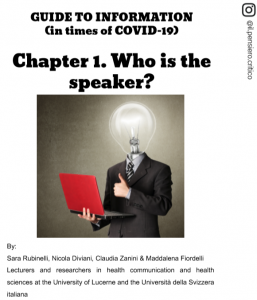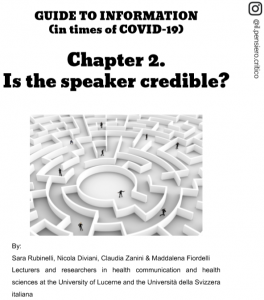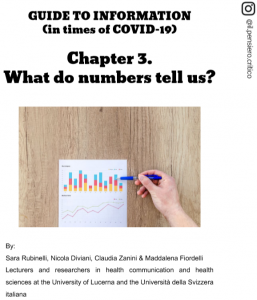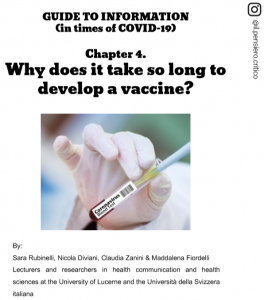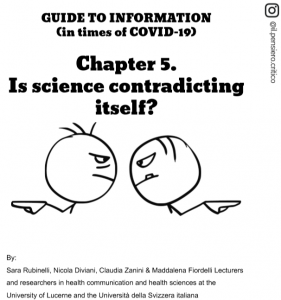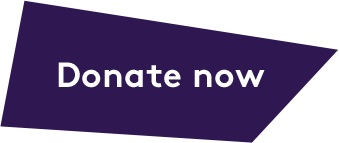By Annemarie Schumacher Dimech, President and Co-Founder of the Women’s Brain Project
Further to the outbreak of the #COVID19 pandemic, Sara Rubinelli started issuing recommendations for the general public on her social media channels. She is a Professor of Health Communication at the University of Lucerne, and President of the International Association for Communication in Healthcare.
Background: The importance of communication in health crises
The COVID-19 pandemic and the ensuing measures have changed our daily life considerably within a very short span of time. Although the focus right now is on controlling the spread of this virus as well as finding an effective cure, the psychosocial effects of this situation should not be neglected.
Studies conducted during or after past pandemics on subjective well-being found both negative and positive outcomes. In spite of a reduction in well-being, particularly in vulnerable groups (e.g. the chronically ill, women, and unemployed), a stronger sense of community was also reported.
A recent review by the Lancet of studies investigating the psychological impact of quarantine confirmed these findings, and emphasized the importance of communication.
The role of communication in the media as well as on a policy level indeed has a huge impact on people’s reactions, affecting behaviours and mental health. The goal is to empower people to take necessary precautions to safeguard their health and that of others.
As one study put it: “Ideally, pandemic communications maximize the public’s capacity to act as an effective partner by encouraging prevention, promoting containment, and fostering resilience and recovery”.
So, let’s dive in.
Interview with Professor Rubinelli

Prof. Rubinelli, what motivated you to start publishing recommendations for the public on social media on how to manage information about COVID-19?
Information about COVID-19 is ‘technical’: it often implies knowledge of epidemiology, medicine, public health, economics and, moreover, of scientific thinking as a process to build or analyse evidence.
This is not something that comes naturally to most people. That’s why, with my colleagues Nicola Diviani, Claudia Zanini, and Maddalena Fiordelli, we decided to publish some guidelines [see visuals at the end of this article] to assist people in evaluating information about COVID.
We are not experts in medicine, so we do not write about what is right and wrong in dealing with COVID-19 as a health condition. However, we provide tips that people can use to evaluate whether or not information is based on scientific evidence. If it isn’t, then it is a point of view.
Why did you choose this particular format?
We looked for a medium that can be easily used and implemented, which is why we decided to use Instagram. Taking an overly detailed approach or discussing how science works would be interesting from a knowledge perspective, but short guidelines are, in our view, the best way to give practical advice that people can really use in their daily life.
How would you describe the impact of communication in a situation such as the current one?
Massive! Communication plays a main role. The World Health Organization (WHO) went as far as to speak about an “info-demic”, a pandemic of information!
Everybody speaks about COVID-19, but the sources are not always qualified to say the things they say. For example, there have been actors who spoke about how patients should be treated. That’s their point of view, and should not be shared as if it were scientific fact.
I understand that in a world of freedom of speech, everybody can say what he or she thinks. Nevertheless, we have to be careful on how we express our opinions, because what people hear or read influences attitudes and behaviour: and it is very dangerous if people do not fully understand the risks associated to COVID-19.
They might develop a perception of risk that is too low (e.g., think that COVID-19 is like a flu) or too high (e.g., that everybody is at high risk of dying).
What are the risks of fake news and incorrect information?
As I was saying, our risk perception is influenced by several aspects including our knowledge and beliefs. When we rely on misinformation, we might end up engaging in suboptimal behaviours.
There are different types of misinformation: fake-news, reconstruction of the events through conspiracy theories that are unsupported, non-experts that are influencers and therefore are persuasive, individual views not supported by scientific evidence.
I think we need to thoroughly explain in a comprehensible way the phenomenon of an “info-demic”. We cannot tell people what they should believe. Most of us live in democracies where everybody is free to believe what they want. However, it is important to make people aware when something is – or is not – based on evidence.
Have you observed gender differences when it comes to health communication?
There are gender aspects in the way health providers are portrayed on the media. One such example is that very often, males are more prominent than women in articles and photos about COVID-19 (and this in spite of women making up 70% of healthcare workers, according to the World Health Organization).
But on this topic, I would need to do a proper study to confirm what at the moment is a hypothesis.
There are definitely differences, as for instance women tend to be the ones taking care of children and elderly parents, so their understanding of prevention measures can have a catalytic effect.
In all types of communication, gender stereotypes and biases create a priori assumptions in our minds, thereby influencing our communication with others. In the clinical context, these biases affect both clinicians’ perception of their patients as well as patients’ and public’s expectations (also in terms of non-verbal communication). There is also evidence of gender-differences in communication – for example, female doctors provide more psychological support during the conversation while male providers insist more on the evidence-based aspect, they spend more time presenting tests rather than talking about how the patient feels.
How can communication contribute to addressing health inequities, or support vulnerable groups in a time of crisis?
Health institutions can present tailored information that address vulnerable groups especially. These groups are not easily reached by top-down communication. Thus, different target audiences have to be clearly defined and an analytical effort is needed to understand how to deliver information in ways that is comprehensible and that actually reach them.
All of this cannot be easily done in an emergency situation.
Therefore, institutional risk communication for public health threats have to be planned long before a crisis. This means investing resources into strategic and crisis communication.
How can communication help cope with the after-effects of the COVID-19 pandemic?
I am not a psychologist, but I have my personal view on this. Communication supports the expression of feelings. At the moment, we need to verbalise our emotions, label our beliefs, fears, stress, and all the negative aspects that derive from witnessing this challenging time in our history.
This is not only a public health crisis; it is an economic crisis, and it challenges a lot of certitudes we had before. We somehow need to rebuild ourselves. Some people are doing this already, whereas others need more support.
Communication is key. It is a channel for the governments, but also for individuals and communities to to work together to equip our future society to deal with the unexpected.
Communications during COVID-19
Rubinelli and her team put out their guidelines as five “chapters”. Each visual below represents one of the chapters and links to the corresponding pdfs with the full content are below.
- Who is the speaker?
- Is the speaker credible?
- What do numbers tell us?
- Why does it take so long to develop a vaccine?
- Is science contradicting itself?
- Chapter 1: Who is the speaker?
- Chapter 2: Is the speaker credible?
- Chapter 3: What do the numbers tell us?
- Chapter 4: Why does it take so long to develop a vaccine?
- Chapter 5: Is science contradicting itself?
For additional chapters (in Italian only for now), visit “il pensiero critico” on Instagram.



